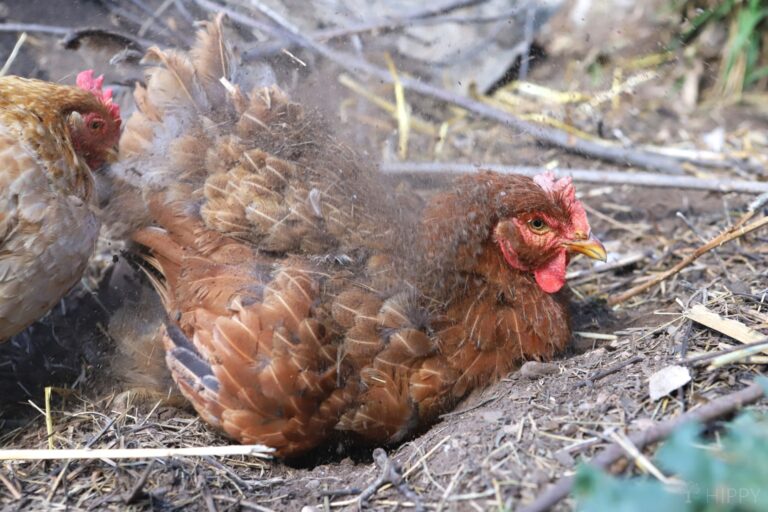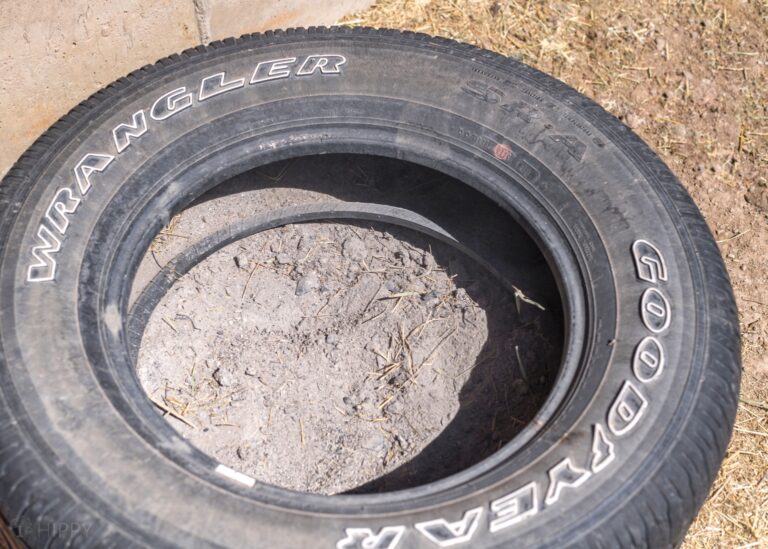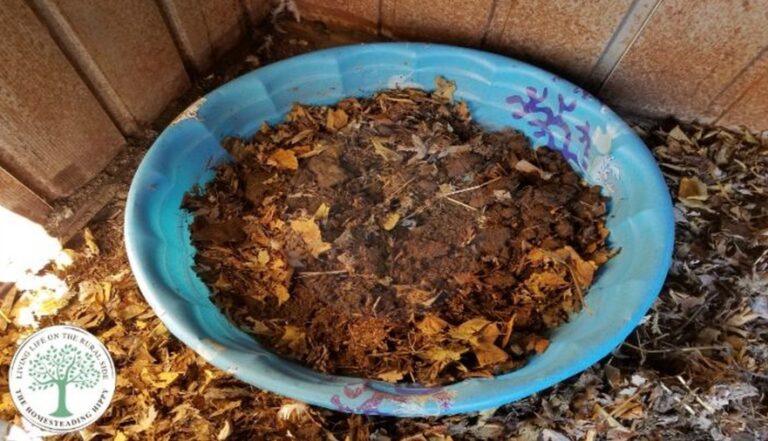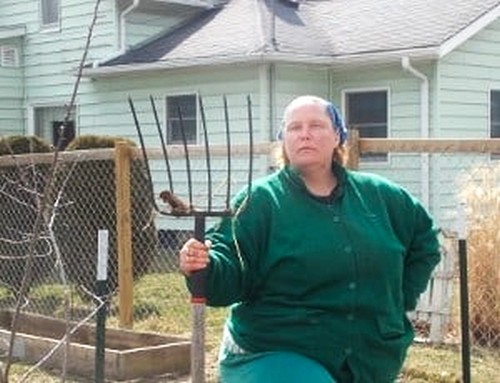Chickens like to take baths. Not with water, though. Trust me, giving a chicken a water bath is not the best way to spend a weekend afternoon. The next best thing is to create an area in your run or coop for your chickens to dust bathe. Here’s how to do it – and why you really should!

What is a Chicken Dust Bath?
A chicken dust bath is an essential part of a chicken’s hygiene routine. It helps to remove dirt, parasites, and other debris from the feathers and skin. Dust baths also help to regulate a chicken’s body temperature and keep their feathers in good condition.
To take a dust bath, chickens will first find a dry, loose spot of dirt or sand. They will then start flapping their wings and kicking up the dust, covering their bodies in a fine layer.
Once they are thoroughly coated, they will shake off the excess dust and return to their normal activities.
Chicken owners can provide their feathered friends with a designated dust bath area, or they can simply let them find their own spot in the yard.
Why Do Chickens Take Dust Baths?
Chickens like to take dust baths. They will find some loose dirt, dig a space, and lay down. Then, they will roll around, kicking up the dust onto themselves.
The first time you see it, it can look like the chickens are convulsing. Or dying. Or both. The chicken can spend up to 20 minutes in the dust bath, rolling about and chilling out.
Why do chickens take dust baths? For a couple of reasons:
- it helps to cool them in the warmer summer months
- it helps to keep lice or other pests at bay
- it helps to dry up greasy feathers
In the summer months when there is plenty of open dirt, chickens can easily make their own dust bath area. We sprinkle some DE (food grade) where the dust bath holes are. It’s easy to find them.
They are huge holes, easily fitting 2-3 chickens in them at once. Our chickens will also go back to the same place time after time to dust bathe there.
What is the Ideal Depth and Size for a Chicken Dust Bath?
Dust bathing is a very social event for chickens. They enjoy bathing together; therefore, if you have a small flock of +/- 10 chickens, your bath should be able to accommodate 4 to 5 chickens comfortably at the same time.
As your flock grows, you will need to provide a bigger bath to accommodate the growing number of spa users.
They are huge holes, easily fitting 2-3 chickens in them at once. Our chickens will also go back to the same place time after time to dust bathe there.
According to poultry experts, a chicken dust bath should be about 6 inches deep and have a diameter of 2-3 feet.
The depth is important because it allows the chickens to fully immerse themselves in the dust. The diameter is also important because it allows multiple chickens to bathe at the same time without getting in each other’s way.
Any Container Can Be a Dust Bath…
Just Dig a Hole
As the title says, simply dig a hole in the ground and fill it with sand or fine dirt.
It should be big enough for the bird to fit into and deep enough to cover the bird’s body when it is buried. Once you have created the bath, just sit back and watch the birds enjoy themselves!
Try Using a Shallow Bin
Fill the bin with a mixture of sand and dirt, and then add some wood ash or diatomaceous earth to help absorb moisture. Place the bin in a warm, sunny spot, and let your chickens enjoy a refreshing dust bath.
Make a Dust Bath From an Old Tire
Simply place the tire in a shady spot and fill it with sand or dirt. The chickens will then jump in and start dusting themselves.

So if you’ve got an old tire taking up space in your yard, put it to good use by making a dust bath for your chickens.
Use Sandboxes
You can easily build a dust bath by filling a sandbox with sand. The sand should be fine-grained and free of any chemicals or other contaminants. You can also add a little bit of gravel or crushed oyster shells to the sand to help with drainage.
Once the sandbox is filled, place it in a warm, sunny spot in your yard where your birds can enjoy their dust bath without being disturbed.
Many toy stores, hardwood stores, or carpentry stores can supply sandboxes made to order and can build lids to keep them dry.
Broken or Old Kiddie Pool
One simple solution is to use a broken or old kiddie pool. We use broken ones that once served as pools for our ducks. This helps to recycle what we have, keeping our garbage down, as well as keeping all our flocks happy.
We use broken ones that once served as pools for our ducks.
This helps to recycle the old plastic shells we have, minimizing our environmental footprint, keeping our garbage down, as well as keeping all our flocks happy.

Place the kiddie pool in an area where snow, rain, or water will not be able to get to it. Or at least not much.
Our “barn” isn’t very watertight on the inside, but it works. We put the kiddie pool close to where the chickens roost and where their food is for easy access.
Another benefit of using kiddie shells is that they normally come with two halves. Half can be used to hold the sand while the other is used to cover it up, protecting the dust from weather and cats who think any area dedicated to sand is there for the cats to relieve themselves in.
Secondhand shells are easy to get from parents whose kids have outgrown them, or from secondhand stores.
Planks
When my kids were little, we had so much fun using leftover planks from a construction project.
Be creative when designing the bath. Make it square, make it a triangle, make it a rectangle, or do what we did and make a star with many angles or different lengths of planks.
Dig a shallow groove for each plank to sit in so that the sides do not cave when you add the dust.
Logs or Tree Stumps or Trees That Have Been Cut into Different Sizes
If you can find some logs, you can build a shape out of the logs to contain the sand. The chickens will love perching on the logs too.
The logs can hold the dust in them and also provide perches for the chickens who want to hang out together but do not necessarily need to take a bath.
Cat Litter Pan
I found cat litter pans a bit small for my big flock, but, if you have a small flock of bantams or chicks, you can supply several pans placed close to each other so that more than one chicken can bathe at a time.
The pan must be 8 to 12 inches deep.
Wooden Box
Every inch of me needs to say it, at least the naughty inch of me, which is every inch of me…
If you have an old coffin lying around… 🤭
On a serious note, wooden boxes are easy to use. If you have an old veggie crate, an old shelf with the racks taken out or left in, or a strong box that something delicate was delivered in, these all make excellent frames for your bath.
Most of my family and friends have a dark sense of humor. I was taken aback the first time I heard my husband’s 70-year-old mom calling old people Coffin Dodgers. Not quite the box I seriously had in mind for my chicken dust bath…
Galvanized Tubs
Galvanized tubs are a bit pricier compared to wooden structures and are restricted in size.
As with the cat litter boxes, you will need more than one tub for social and hygienic purposes.
Plastic Totes
All-sized totes are great to use for dust baths.
What is perfect about them is that most plastic totes come with lids and can be added to with more totes as your flock grows.
Repurposed Craft Organizers
I am a very creative person and always have been, I paint, crochet, bead, and scrapbook. For all of these hobbies, I use plastic divider boxes of all sizes.
I replace them every 1 ½ to 2 years. The old ones, I drill drainage holes in and either use them for dust baths or as planters.
They are always a decent size – because I store so much in them – and they are always fitted with a lid. They are easy to move, clean, and protect the dust from moisture.
These organizers join a functional place with a gossip spot.
Old Plastic Organizer Drawers or Draws from Chests of Drawers
I regularly replace my organizers because, as they age, they start to lose their shape making them hard to open and close.
Organizers have anywhere from 2 to 12 individual drawers, so they can provide ample space for the communal baths and can be easily added onto.
Because the drawers do not have individual lids for each drawer, you will need to use a waterproof tarp to keep the dust dry.
Wading Pool
Wading pools need to be sturdy enough that they do not burst, or leak and they need to withstand the nails of chickens perching on them.
A doggy wading pool works very well as they cannot be burst by sharp nails.
Raised Flower Beds
I have also used old, raised flower beds to give the bath a sturdy structure.
12- to 14-inch-deep beds are all that are needed.
Rocks
If you like rock gardens, build a base with rocks to hold the dust, and once that is done, create a rock garden on one side. Make sure you design your rock garden with plenty of space to roost or perch while chickens wait for their turn to get in and bathe.
An Old Water Feature
Old water features are fantastic for use in the coop or in a sheltered area.
If you have a steady hand, you can drill holes in the bottom of each tier to drain the moisture that forms in the dust.
Depending on how large the feature is, you may need to place it under a roof. Use a tarp to cover the feature. Repurposed water features are great for inside the coop. They do not require much space, provide baths on various levels, and provide a fun perch for your chickens.
An Old Fish Pond
Small to medium size partially buried fishponds are easy to clean and house more than one chicken at a time.
Chickens do eat ticks, mites, and other parasites. A dust bath is important for chickens to get rid of parasites. It is easy for chickens to eat bugs that are shed in an old fishpond.
For the Chicks – Bird Cage Base
Chicks need a lower bath that is easy for them to get in and out.
A bird cage base is low enough for them to get in and out while holding enough sand.
The sand bath should be small enough for use in the brooder.
Chicks learn to enjoy dust baths by instinct and by watching each other. They do not really need a dust bath when they are little, but the bath is a bit like kindergarten.
Oven Tray
An old oven tray is good for chicks and bantams. They are good for chicks up to 6 to 7 weeks old; they will then be able to use the big girl or big boy baths.
A Bird Bath
I know, ironic right? The basin of a bird bath is easy to use for both chicks and adult chickens. It can be easily moved and cleaned…
How to Make a Chicken Dust Bath
Step 1. Choose a Container
If you’re looking for a container for your dust bath, there are a few things to keep in mind.
The size is the most important, as your chicken will need enough space to move around and fully cover itself in dust. A shallower container will also work well, as it will be easier for your chicken to get in and out of. It’s also important to choose one that has good drainage, as wet dust can cause them respiratory problems.
No matter the container, the bath will need good drainage. You will need to drill holes in the sides and bottom of the bath to allow for good drainage. It is also helpful to place containers on bricks to allow moisture to drain properly without trapping the moisture in the bottom or under the bath.
Finally, you’ll want to make sure the container is sturdy enough to withstand some vigorous dust-bathing! Here are some of the best ones you can try…
Step 2. Adding Your Dirt
Add 3-4 shovels of loose dirt. Sandy, loamy dirt seems to work best for us, as it doesn’t get packed down as quickly. We also add some dry leaves between each dirt layer. This helps to keep the dirt aerated.
Step 3. Add Some Extra “Ingredients”
Provide DE
Add a generous sprinkling of DE (diatomaceous earth) on top of the dirt, and watch your chickens clamor for their new “spa” area!
This dirt WILL get disappear over time as the chickens push it out during their bath. When this happens, we rake up the dirt and add it back in as much as possible.
Fireplace Ash
Many people recommend adding wood ash to the mix. Wood ash helps to absorb moisture and can also help to control parasites. As a result, it makes an excellent addition to any dust bath.
Fragrant Herbs
One way to keep chickens interested in their dust bath is to add some fragrant herbs. Many chickens enjoy the scent of lavender, rosemary or mint, and the herbs can also help to repel parasites.
To use, simply mix a handful of fresh or dried herbs into the dust bath. The scent will help to keep chickens occupied while they are bathing, and it will also help to keep their feathers healthy and free of pests.
Other good herbs to consider adding to your dust bath container include:
- Oregano
- Thyme
- Lemon balm
- Parsley
- Basil
Add Stumps or Logs as Perches
A hen dust bath is simply a shallow pit filled with sand or dirt, which the chickens use to roll around in and preen their feathers. Unfortunately, this often results in the chickens kicking sand and dirt all over the place.
To help contain the mess, try adding stumps or logs around the edge of the pit. The chickens can perch on these, keeping their feet out of the dirt.
This will help to reduce the amount of dirt that gets kicked around, and it will also give your chickens a place to rest while they enjoy their dust bath.
Add Topsoil
You can also add a bag of topsoil from the local home improvement store if you would like to keep the dust bath area more full.
Step 5. Cover the Bath to Keep it Dry
Dust baths can quickly become wet and muddy, making it difficult for chickens to stay clean.
To prevent this, it is important to cover it with a tarp or other waterproof material. This will help to keep the sand dry and prevent mud from forming after rain showers.
A Few More Dust Bath Tips
Here are a few more tips on how to make sure your dust baths are clean and fresh.
Introduce Your Girls to it Early
It is beneficial to provide your girls with a dust bath area early on so that they are used to it. You can use a simple sandbox, or even just an empty cardboard box filled with sand or dirt.
How to Dry Out a Chicken Dust Bath
If your chicken dust bath got rained on, there’s no need to fret. There are a few simple steps you can take to dry it out so that your chickens can continue to enjoy their dust baths.
- First, wait for the rain to stop and then remove any standing water from the bath.
- Next, add more fresh, dry dust to the bath and mix it around until the desired consistency is achieved.
- Finally, let the sun and wind do their work by allowing the bath to dry out completely before your chickens use it again.
Do Baby Chicks Need Dust Baths?
Many people believe that baby chicks need dust baths in order to stay clean and healthy. However, this is not actually the case.
Baby chicks do not have fully developed feathers, and their bodies are not yet able to produce the necessary oils for a dust bath.
In fact, giving a baby chick a dust bath can actually be harmful. The dust can irritate their skin and eyes, and it can also lead to respiratory problems as their respiratory systems aren’t quite well developed enough yet.
For these reasons, it is best to wait until a chick is older before giving them a dust bath.
Know What NOT to Put in a Dust Bath
Ah, the dust bath. It’s a key part of a bird’s grooming routine, and it’s also fun to watch them fluff up and get all coated in dust.
But what many people don’t realize is that not just any old substance can be used for a dust bath. In fact, using the wrong material can actually be harmful to birds.
One common mistake is using kitty litter. Cat litter is made of clay, which can adhere to a bird’s feathers and cause respiratory problems.
Additionally, kitty litter often contains chemicals that can be toxic to birds. Sawdust can also be problematic, as it can stick to their feathers and be difficult to remove.
You can use charcoal, but only in moderation. Wood shavings are fine in the coop but don’t have much of a place in the dust bath mixture, since they won’t necessarily help your chickens clean themselves and don’t really have antibacterial properties, either.
Final Thoughts
A chicken dust bath is essential for your backyard chickens to prevent mites, fleas, lice, and all kinds of other problems. It’s perfect for free-range birds as well as those who live most of the year in a chicken coop.
What do you do to help keep your chicken flock happy? Do you make a dust bath area for them or will you try it now? Be sure to pin this for later!

Heather’s homesteading journey started in 2006, with baby steps: first, she got a few raised beds, some chickens, and rabbits. Over the years, she amassed a wealth of homesteading knowledge, knowledge that you can find in the articles of this blog.
Learn more about Heather and the rest of the writers on this page.

We heat with wood in the winter here. It is also so cold here in northern Canada that we have to keep them inside from Nov to Mar if we are going to get eggs in the winter. So space is limited. We allow aprox 5 sq ft of floor space per bird. What I have done for years is put cold dry wood ash in 1 of the nest boxes. They must be using it for dust baths, because we have to top it up periodically & they never lay eggs in it. They still dust-bath outside & in the deep litter/compost some. But we have never had any sign of lice problems.
adding wood ash is a GREAT idea!